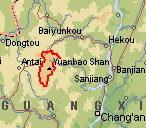
Approximate distribution of Abies yuanbaoshanensis (Farjon 1990). Map by www.expediamaps.com.
Abies yuanbaoshanensis
Yuanbaoshan fir, Yuanbaoshan lengshan [Chinese] (Farjon 1990).
It seems to be most closely related to A. forrestii and is placed in section Pseudopicea, subsect. Delavayianae (Farjon 1990).
Dioecious evergreen trees to 25 m tall and 60 cm dbh, typically with a single straight round bole and a crown of long, horizontally spreading branches. Bark first smooth, with age becoming shallowly grooved or breaking into plates. Twigs slender, firm, yellowish or light brown in first year, glabrous, with circular leaf scars. Buds ovoid-conical, very resinous. Leaves subradially spreading on upper surface of shoot, lower leaves spreading laterally, erect or assurgent on sun foliage; all leaves 10-27 × 1.8-2.5 mm (except leaves on shade-grown saplings pectinately arranged and up to 3.8 cm long), linear, flattened, with revolute margins and a medial groove above, twisted or curved at base, apex obtuse or emarginate; stomata absent on the dark green upper surface, present on lower surface in two white bands on divided by a midrib. Pollen cones solitary, axillary, on short branches, 1-1.5 cm long, yellow when fertile. Seed cones lateral, erect, short-pedunculate to sessile, broad ovoid or cylindric with an obtuse apex, 8-9 × 4.5-5 cm, yellowish green maturing to yellowish brown; rachis persistent, fusiform or conical. Cone scales cunate or flabellate, 20 × 22 mm at mid-cone, smooth, exposed part dense puberulent and light gray, upper margin rounded, slightly recurved. Bracts oblong, maximum width 9 mm, distinctly exserted, reflexed. Seeds ca. 10 × 4 mm with a 9-11 mm long wing ( Farjon 2010). Also see the Flora of China (Wu and Raven 1999).
China: N Guangxi. The type locality, and still the only known locality, is in Rongshui Xian on Yuanbao Shan at 1700-2050 m elevation (Farjon 1990). The area is in high mountains with annual rainfall summer-wet, exceeding 2000 mm, cool and wet in summer and very snowy from December to March. The Abies are widely scattered in mixed conifer forest with Tsuga chinensis and hardwoods dominated by Fagaceae spp. ( Farjon 2010). Hardy to Zone 6 (cold hardiness limit between -23.2°C and -17.8°C) (Bannister and Neuner 2001).
The IUCN has designated this species as "Critically Endangered" due to its very restricted distribution (population estimated at 589 reproductively mature plants), severe genetic bottlenecking, and a continuing decline in mature individuals. The habitat appears to be fairly stable, with few direct human influences, but the very limited distribution leaves the population open to stochastic high-severity disturbance. The population is within a protected area, but ex situ protection is also desirable (Farjon et al. 2011).
No data as of 2022.12.31.
No uses have been recorded (Farjon 2010).
No data as of 2022.12.31.
The epithet refers to the type locality on Yuanbao Shan.
Farjon, Aljos. 1990. Pinaceae: drawings and descriptions of the genera Abies, Cedrus, Pseudolarix, Keteleeria, Nothotsuga, Tsuga, Cathaya, Pseudotsuga, Larix and Picea. Königstein: Koeltz Scientific Books.
Farjon, A., and 14 co-authors. 2011. Abies yuanbaoshanensis. The IUCN Red List of Threatened Species 2011: e.T32319A9696565. https://dx.doi.org/10.2305/IUCN.UK.2011-2.RLTS.T32319A9696565.en, accessed 2022.12.31.
Fu Li-Kuo, L. Yong-Jun and Mo Sin-Li. 1980. The genus Abies discovered for the first time in Guangxi and Hunan. Acta Phytotaxonomica Sinica 18(2):205-210. Available online at the Journal of Systematics and Evolution.
Jie Yang, Tao Ding, Ri-Hong Jiang, Ya-Rong Wang & Xiang Qiao-Ping. 2019. The complete chloroplast genome of the Abies yuanbaoshanensis, an endangered Pinaceae species in Southern China. Mitochondrial DNA Part B 4:2, 3386-3387, DOI: 10.1080/23802359.2019.1674210.
The species account at Threatened Conifers of the World.
Last Modified 2025-02-10